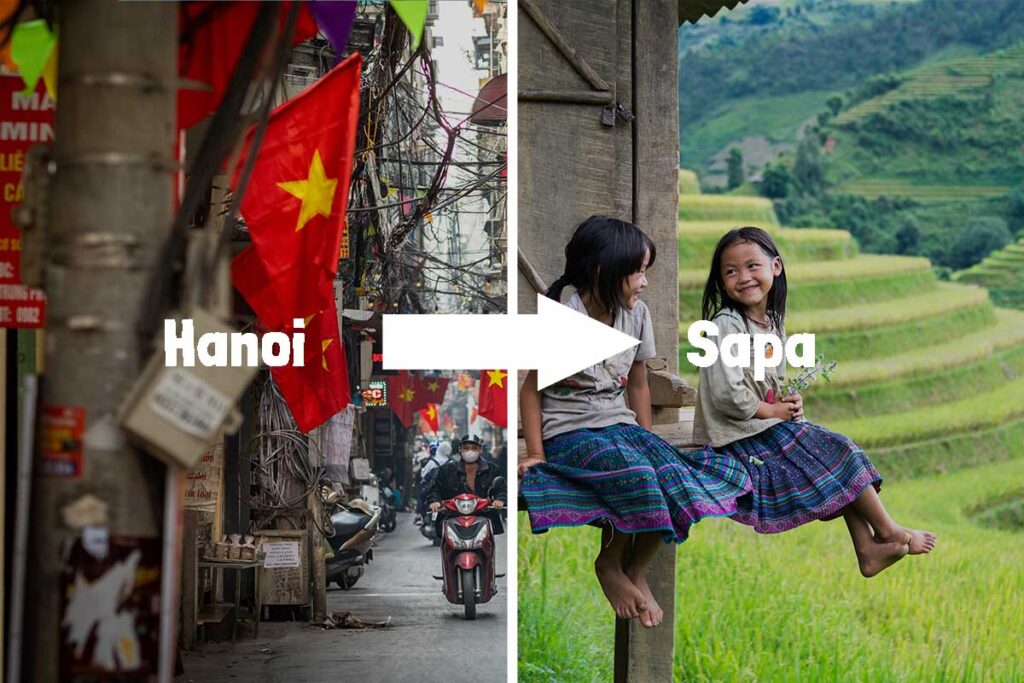Hanoi – the gateway to Sapa
Sapa is one of the most famous destinations in northern Vietnam, well-known for its terraced rice fields, ethnic minority cultures, mountain trekking, and Fansipan — the highest peak in Vietnam. Whether you’re coming to experience the stunning rice terraces, hike through remote villages, or simply enjoy the cool mountain air, Sapa is a must-visit in northern Vietnam.
Meanwhile, Hanoi is the capital city and the main transportation hub for northern Vietnam. Almost all travel routes — whether from Ninh Binh, Cat Ba, Halong Bay, Mai Chau, or other regions of Vietnam — pass through Hanoi before continuing to Sapa.
That’s why so many travelers are searching for how to get from Hanoi to Sapa — it’s the natural starting point for almost every journey to this mountain town.
About the route from Hanoi to Sapa
The distance from Hanoi to Sapa is around 450 kilometers (~280 miles). While that sounds far, the journey is made easier thanks to modern infrastructure.
A big advantage is the new express highway that connects Hanoi to Lao Cai, the town located at the base of the mountains near Sapa. This highway has greatly improved travel times — the drive is now much faster, smoother, and with fewer curves compared to other mountain regions in northern Vietnam.
That said, there’s also the option of the historic railway line. The train doesn’t go directly to Sapa but instead to Lao Cai Station. From there, it’s about a 1-hour drive uphill to reach Sapa town.
Option 1: Train from Hanoi to Sapa
How it works
There is no direct train from Hanoi to Sapa. Instead, you take the train to Lao Cai Station, which is the closest railway station to Sapa, located about 30 km (roughly 1 hour by car or bus) from Sapa town.
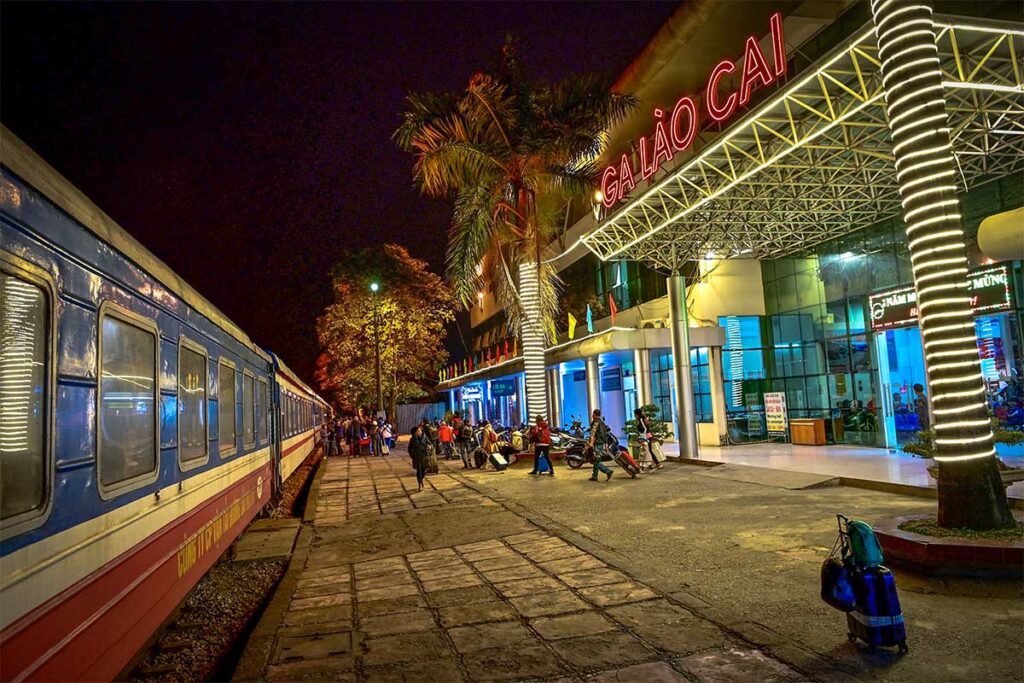
The train journey itself takes about 7.5 to 8 hours. Almost all trains are overnight, which means you board in the evening in Hanoi and arrive early in the morning in Lao Cai.
While the train is slower than the bus, it offers a very different experience. For many travelers, the train is more comfortable, safer, and a charming part of the adventure. Instead of sitting in a bus seat, you get a private bed in a sleeper cabin, allowing you to relax, sleep, and wake up closer to the mountains.
From Lao Cai, you then continue by shuttle bus, taxi, or private car to Sapa. This part is simple and well-organized — transport is always waiting at the station when trains arrive.
Types of trains
There are two types of train experiences on the route from Hanoi to Sapa (Lao Cai):
Vietnam Railways (Standard sleeper)
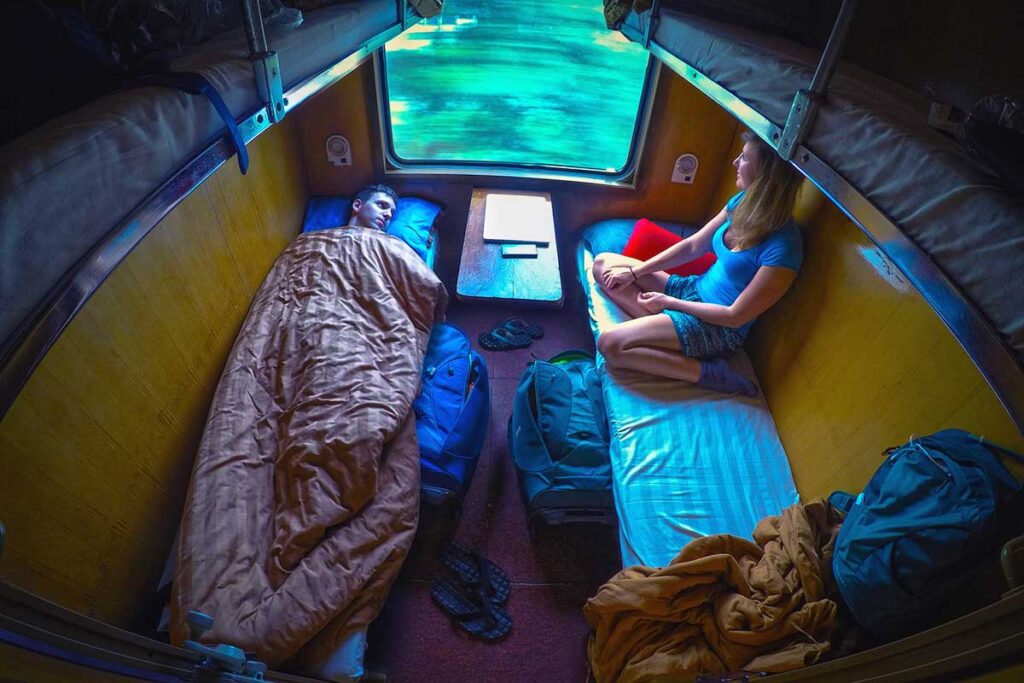
- Basic but functional.
- Sleeper cabins with 4 or 6 beds per cabin.
- Cheapest option — clean but no luxury.
Tourist Trains (Upgraded Sleeper Cabins)
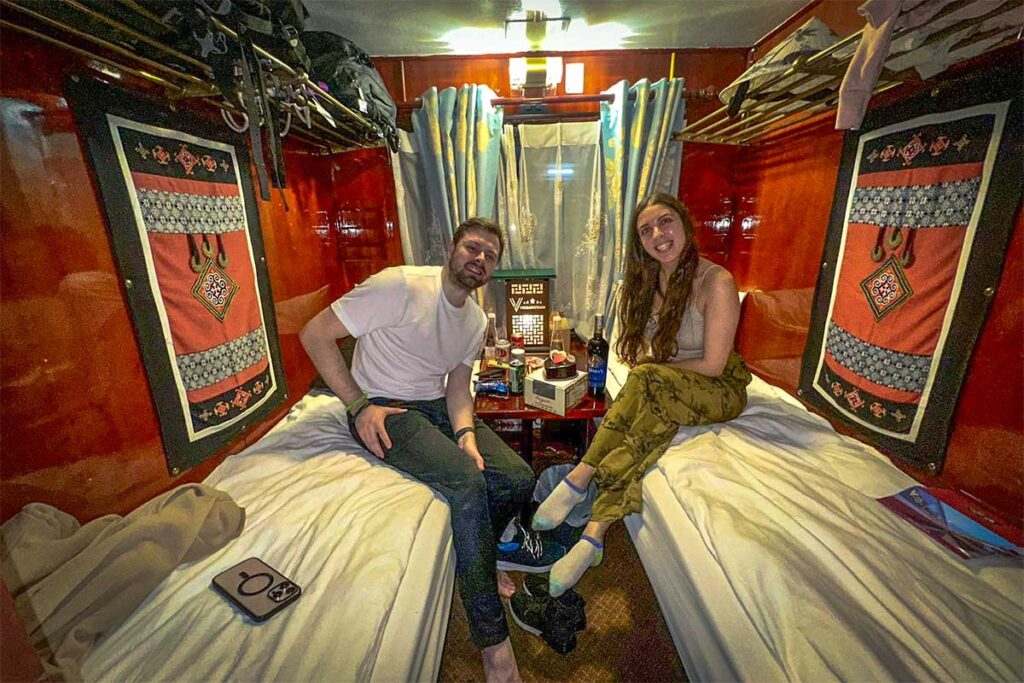
- These are privately operated carriages attached to the main Vietnam Railways train.
- Offer higher comfort levels, better beds, nicer bedding, improved toilets, and often include water, snacks, and a basic breakfast.
- Not a separate train — just private wagons added to the public train.
Tourist trains are the most popular option for travelers seeking more comfort.
Examples of Tourist Trains:
- Sapaly Express – Known for clean, comfortable cabins and good service.
- Orient Express – A reliable mid-range choice.
- King Express – Slightly cheaper but decent comfort.
- Fanxipan Express – One of the more budget-friendly tourist trains, still decent.
Check our detailed guide: Hanoi to Sapa by Train – Best Trains Compared
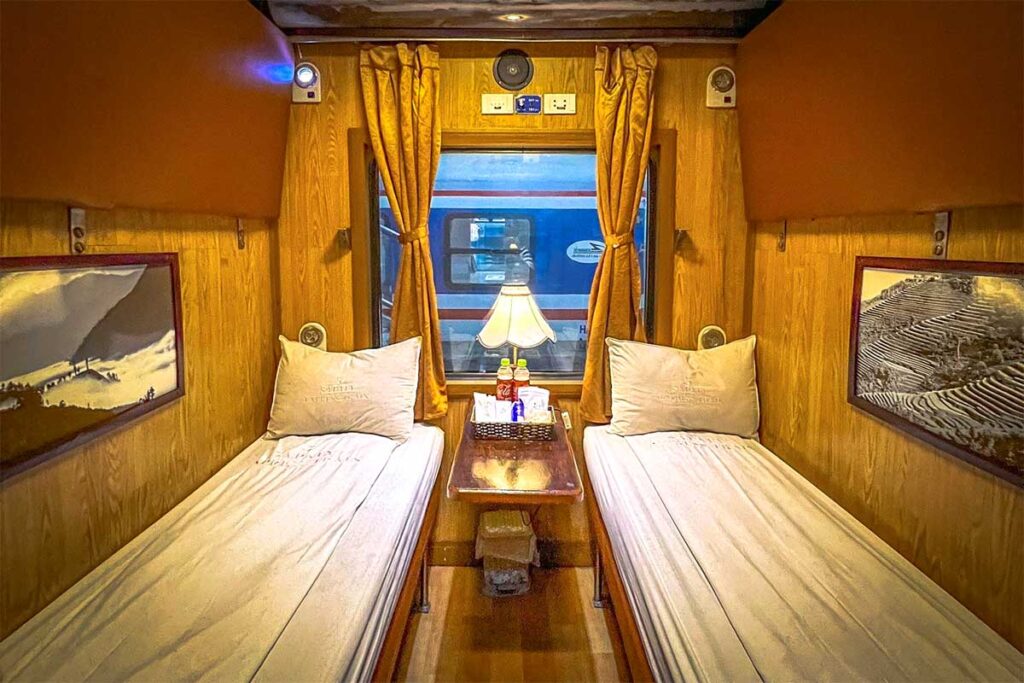
How to book the train from Hanoi to Sapa
For Vietnam Railways (Standard sleeper):
- dsvn.vn — the official website of Vietnam Railways (available in English but slightly complicated to use).
For tourist trains:
- Directly from the train company website.
- Or through reliable platforms like:
- You can also book through your hotel or a local travel agency.
Want the train fully arranged with your Sapa trip?
If you book any Sapa tour with us, we include the train tickets, all transfers from Lao Cai to Sapa, and everything else — trekking, car sightseeing, or ethnic market visits. No hassle, no planning needed — just enjoy the trip.
Important things to know
- Book early. Tourist trains are popular and often sell out, especially on weekends and holidays.
- Do not book a seat. Always choose a sleeper cabin. The seats are upright and extremely uncomfortable for an 8-hour overnight journey.
- Couples: Book a 4-berth cabin for more privacy. Solo travelers can book single berths but will likely share with others unless paying extra for a private cabin.
- For more detailed advice, check our guide: Hanoi to Sapa by Train
Pros – Why take the train from Hanoi to Sapa?
- More comfortable for sleeping than a bus — a real bed instead of a reclining seat.
- Safer and more relaxing feeling, especially for those who dislike overnight buses.
- A charming, classic travel experience through northern Vietnam.
- You arrive early morning and can go straight into activities in Sapa.
Cons – Downsides of the train
- Slower than the bus — about 8 hours on the train plus 1 hour by car to Sapa.
- Requires a transfer from Lao Cai to Sapa.
- More expensive than the cheapest bus options, especially when booking tourist trains.
Option 2: Night buses from Hanoi to Sapa
How it works
Taking a night bus from Hanoi to Sapa is one of the most popular and affordable ways to travel this route. These buses leave Hanoi in the evening or night and arrive in Sapa early in the morning, usually between 4:30 AM and 6:00 AM.
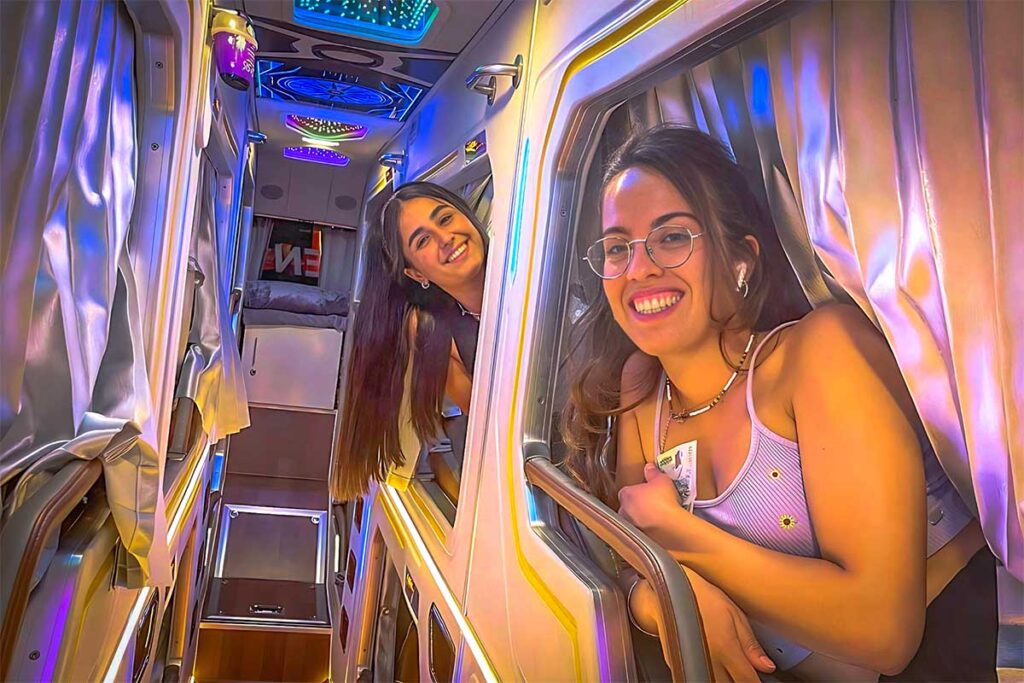
The travel time is around 6 to 7 hours, depending on traffic and weather conditions. Night buses are typically designed as sleeper buses, meaning you’ll get a reclining bunk-style seat rather than a traditional upright seat.
Unlike the train, night buses go directly from Hanoi to Sapa town. This means no transfers are needed when you arrive — the bus will drop you off either at your hotel (if included) or at a central location in Sapa town.
Bus types – Know the difference
Not all buses are the same. Here’s how to choose the right one for your comfort level and budget:
1. Standard sleeper bus
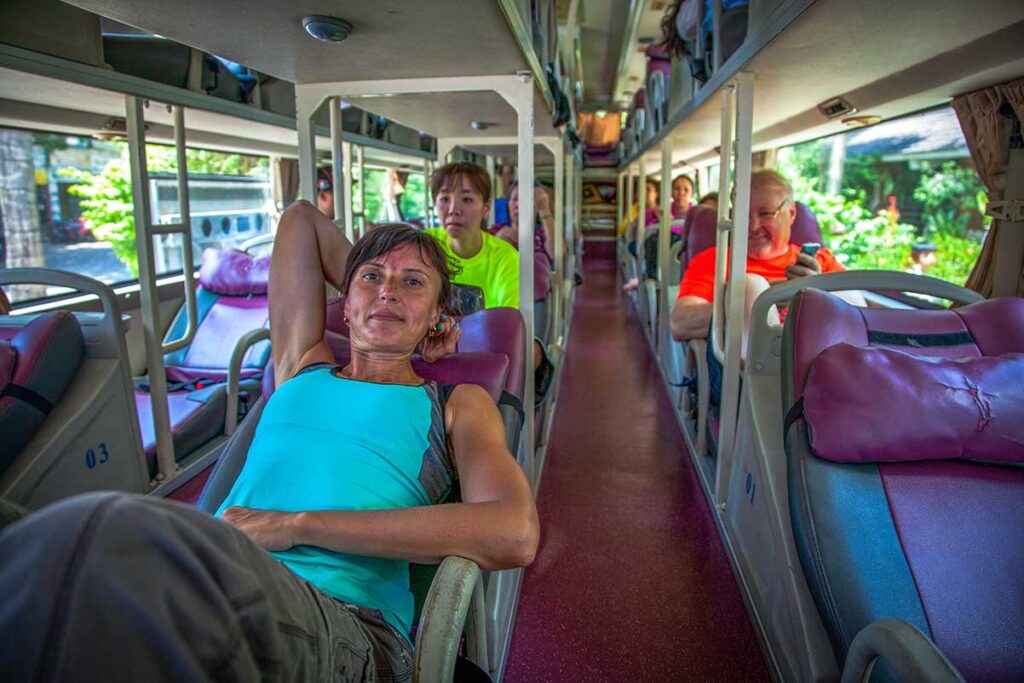
- Basic but functional.
- Reclining bunk seats arranged in two or three rows.
- Often around 36 to 40 beds per bus.
- Less privacy, less space.
2. Limousine sleeper bus
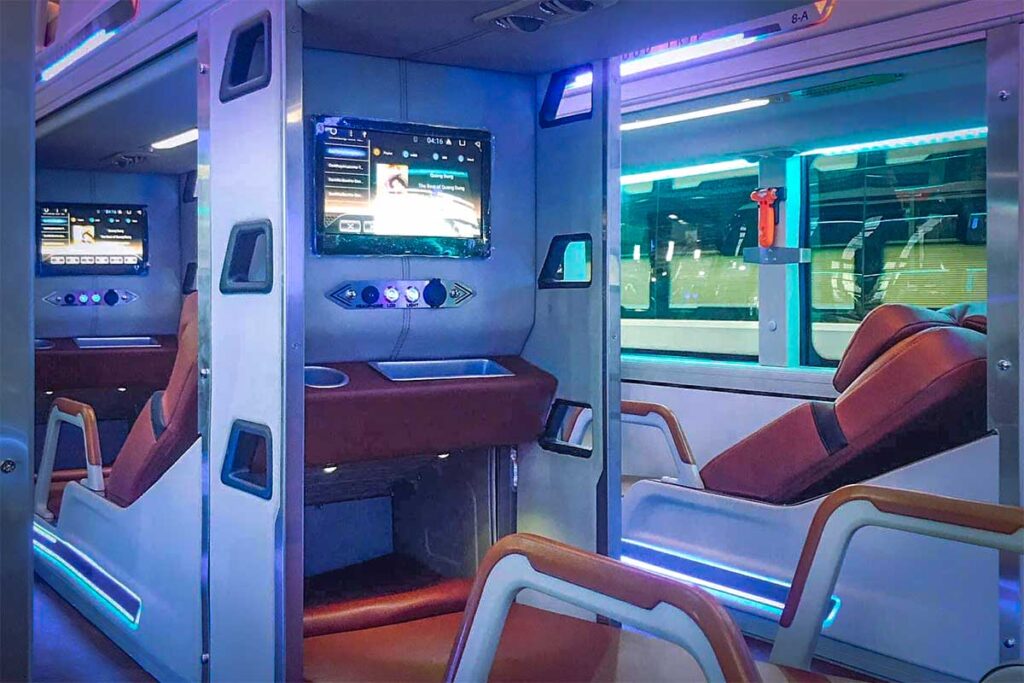
- Slightly upgraded from standard.
- Fewer beds per bus (around 32–34).
- More space per passenger.
- Includes small extras like USB charging ports, privacy curtains, and sometimes Wi-Fi.
3. VIP limousine sleeper
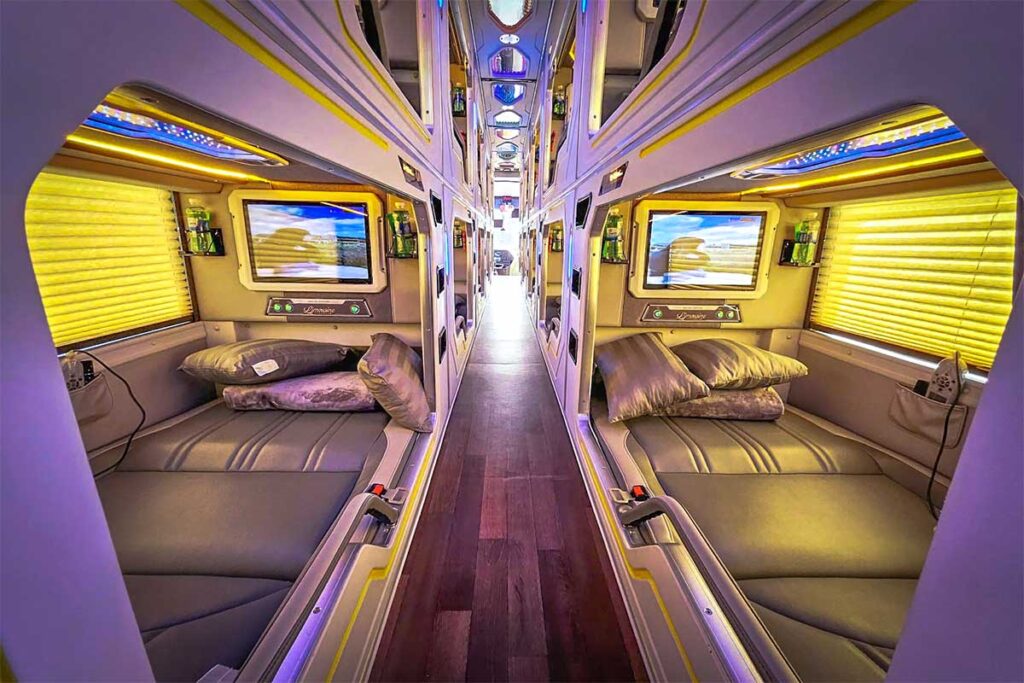
- The most spacious option.
- Typically only 22 to 24 beds per bus.
- Wider beds, more privacy, better sound insulation.
- Includes USB chargers, individual reading lights, curtains, and sometimes a small TV screen per bed.
- Worth the extra cost for light sleepers or those wanting more comfort.
How to book the night bus from Hanoi to Sapa
Booking a night bus is very straightforward. You can:
- Book online via 12Go Asia – easy for international travelers.
- Book online via Baolau – another reliable booking platform.
- Use the Vietnamese site Vexere – more bus options, often slightly better prices, but the interface is less tourist-friendly.
- Walk into any travel agency in Hanoi. This is very easy in the Old Quarter — agencies are everywhere.
- Book through your hotel in Hanoi. This can be convenient because the hotel can help confirm pickup times, contact the bus company, and ensure you’re collected from your hotel directly.
Book your sleeper bus as part of a full Sapa trip
Skip the stress of figuring it all out. Our Sapa tours can include the sleeper bus from Hanoi, plus all transfers, guided trekking, car tours, or market visits — fully arranged from start to finish.
Pros – Why take the night bus from Hanoi to Sapa?
- Cheapest way to travel from Hanoi to Sapa.
- Direct to Sapa town — no transfer needed at Lao Cai.
- Saves a night on accommodation. You travel while you sleep.
- Many buses offer door-to-door drop-off in Sapa, depending on the company.
- Frequent departures in the evening, giving flexibility.
Cons – Downsides of the night bus
- Some people don’t sleep well on buses, especially if not used to bunk-style seats.
- The last stretch to Sapa involves mountain roads with curves, which can be uncomfortable for those prone to motion sickness.
- Less privacy and space compared to a train cabin.
- Bus comfort varies a lot between companies — always check reviews before booking.
Option 3: Daytime buses from Hanoi to Sapa
How it works
If you prefer not to travel overnight, daytime buses from Hanoi to Sapa are a comfortable alternative. These buses leave Hanoi in the morning or early afternoon and arrive in Sapa the same day, typically 6 to 7 hours later.
This is a great option for travelers who want to enjoy the scenery along the way, don’t sleep well on buses, or prefer not to arrive in Sapa in the early morning hours like with night buses.
Bus types – What’s available?
1. Sleeper Buses (Used during the day)
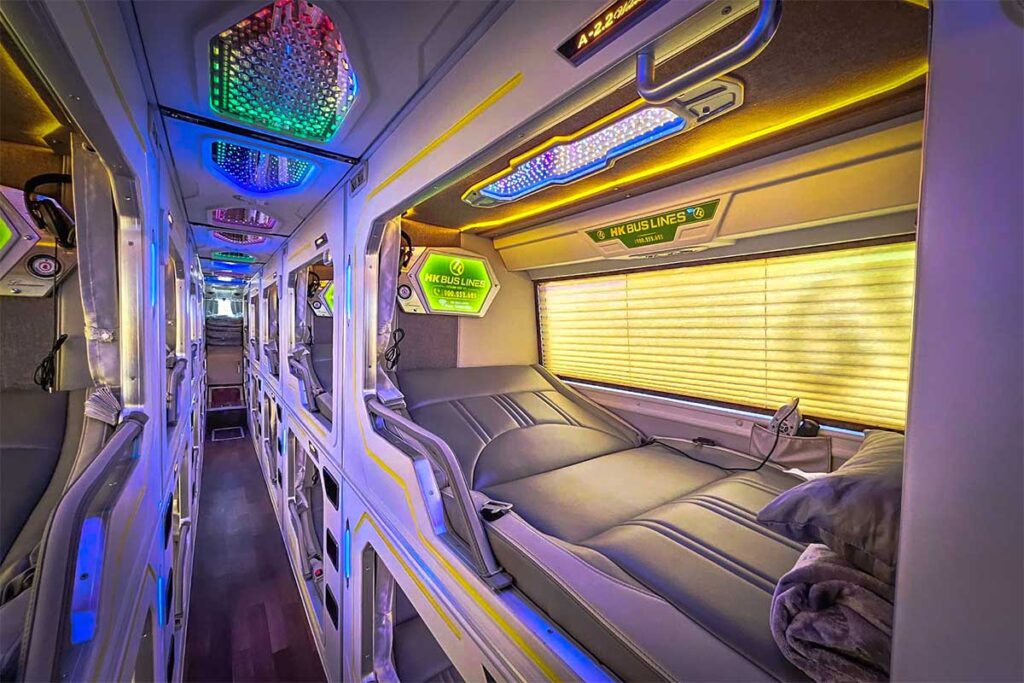
- Same type of bus as the night buses, but operating in daylight hours.
- Reclining bunk-style beds, arranged in two or three rows.
- Good for travelers who don’t mind lying down during the day.
- Less social and upright than regular bus seats — some people find it odd for daytime travel.
2. VIP Limousine Vans
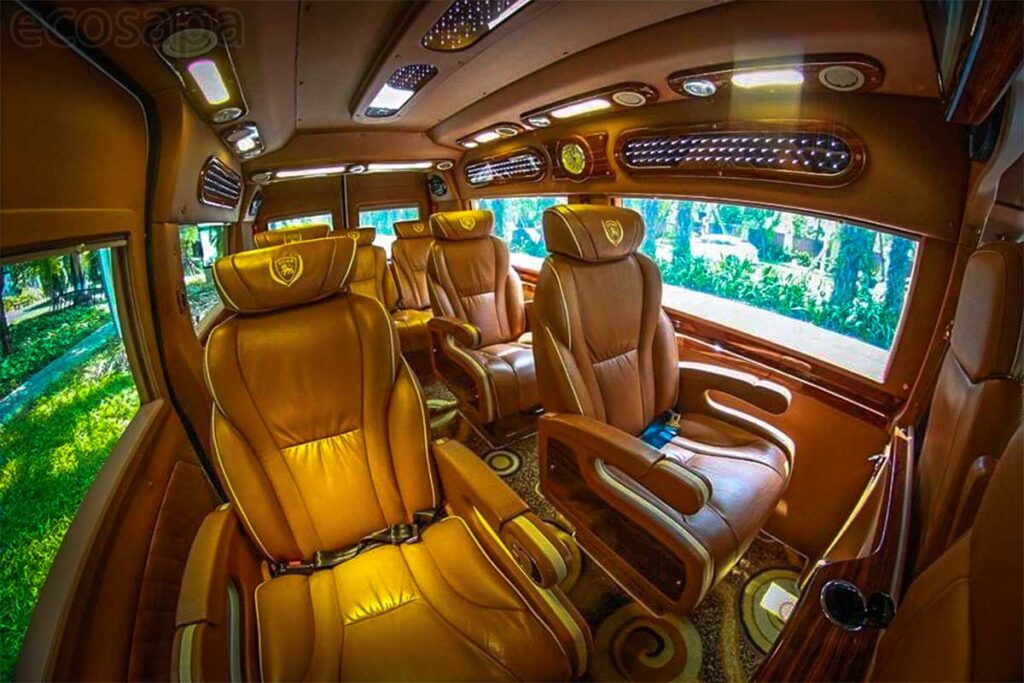
- 9 to 16-seat luxury vans.
- Comfortable seats (not beds) with lots of legroom.
- Often equipped with Wi-Fi, USB charging ports, air-conditioning, and reclining leather seats.
- More privacy, less crowded than big buses.
- A favorite for couples, families, or small groups looking for comfort without the hassle of a private car.
How to book the daytime bus from Hanoi to Sapa
It works exactly the same as booking a night bus:
- Online via 12Go Asia — simple, with clear departure times and bus types.
- Online via Baolau — a reliable alternative for bus bookings in Vietnam.
- On Vexere — has the widest selection of Vietnamese bus operators but may require a bit more navigation effort.
- At any travel agency in Hanoi. Walk in, check schedules, and they’ll arrange everything.
- Via your hotel in Hanoi. Especially handy for door-to-door service — they communicate directly with the bus operator to arrange your hotel pickup time and make sure everything is organized smoothly.
Daytime bus to Sapa? Let us arrange your full trip
Prefer not to travel overnight? Our Sapa tours can include your daytime bus from Hanoi, plus comfortable accommodation, trekking, car sightseeing, and everything else — all fully arranged for you.
Pros – Why take a daytime bus from Hanoi to Sapa?
- The main reason people choose this option is simple: they don’t want to travel overnight. Whether it’s because it feels less safe, uncomfortable, or they know they won’t be able to sleep properly on a moving bus — a daytime trip avoids that stress completely.
- Enjoy the changing scenery, especially the mountain views as you approach Sapa.
- VIP limousine vans are very comfortable, especially if you dislike bunk-style sleeper buses.
- You arrive in Sapa in the afternoon or early evening, which feels more natural for check-in and starting your trip.
Cons – Downsides of the daytime bus
- Takes up most of the day, meaning you lose a full day to travel instead of sightseeing.
- Sleeper buses during the day are less comfortable for sitting upright.
- If you only have limited time, this might not be the most time-efficient option.
Option 4: Private car from Hanoi to Sapa
How it works
A private car from Hanoi to Sapa is the most flexible and comfortable way to travel. It’s door-to-door service with a driver, meaning you can leave any time you want, stop anywhere along the way for a coffee, meal, or scenic photo, and go at your own pace.
This is a great option for families, small groups, couples, or anyone who doesn’t like the idea of buses or trains.
The drive is around 5.5 to 6 hours on the express highway, plus a short break.
Car Types – What’s available?
5-Seater Sedan (Toyota Vios, Hyundai Accent, etc.)
- Fits the driver + 2 to 3 passengers comfortably.
- Best if you don’t have too much luggage.
7-Seater SUV (Toyota Fortuner, Innova, Xpander, etc.)
- This is the most common car type for private transfers in Vietnam.
- Fits the driver + 4 to 5 passengers.
- Important note: The back two seats are quite small, specially when you are tall. If you’re a group of 5, expect less legroom in the back row.
- If you have a lot of luggage, the back seats may be folded to make room, meaning the car is then better for 3-4 passengers.
9-Seater Limousine Van
- VIP limousine buses
- Perfect for small groups of 5–7 people with lots of luggage.
- Very spacious seats, lots of legroom, reclining chairs, air-conditioning, USB charging.
- This is the same type of van you can book by seat on a shared limousine service, but in this case, you book the entire van privately.
16-Seater Minibus (Ford Transit, Hyundai Solati)
- Ideal for larger groups or travelers with lots of luggage.
- Also commonly used for small group tours.
- Not as luxurious as the 9-seater limousine, but very practical and spacious.
Cost estimate
- 5-seater: From $160–180 USD per car.
- 7-seater SUV: From $180–210 USD per car.
- 9-seater limousine van: From $210–250 USD per van.
- 16-seater minibus: From $230–300 USD per van.
(Prices can vary depending on company, season, and included services.)
How to book a private car from Hanoi to Sapa
The easiest and most reliable way to book a private car is through a local travel agency. This ensures better communication, clear pricing, and a driver who knows the route well.
Many local agencies (including us) offer this service with upfront pricing and door-to-door pickup from your hotel in Hanoi to your hotel in Sapa.
Some international booking platforms, like 12Go Asia or Baolau, also offer private car bookings on this route, but the selection is limited compared to local agencies.
Rent a car with driver from Hanoi to Sapa
We can arrange a private car or van with driver for the trip from Hanoi to Sapa — with flexible timing and comfortable door-to-door service. Need a car in Sapa too, or for a bigger northern Vietnam trip? We can handle that as well.
Pros – Why take a private car from Hanoi to Sapa?
- Fast, flexible, and private. Leave anytime you like.
- Door-to-door service — no transfers, no waiting.
- More comfortable than any bus or train.
- Perfect for families, groups, or travelers with lots of luggage.
- You can stop for meals, bathroom breaks, or scenic views whenever you want.
Cons – Downsides of the private car
- More expensive than trains or buses, especially if traveling solo or as a couple.
- If you’re a group of 5 in a 7-seater, the back seats are quite tight — it’s best for 4 adults + luggage.
- Not as social as buses or trains — it’s just you and your group.
Option 5: Driving a motorbike from Hanoi to Sapa
How it works
Driving a motorbike from Hanoi to Sapa is an adventure — but it’s definitely not for beginners.
One important thing to know is that motorbikes cannot use the express highway. This means you must take the older national highways, which are slower, pass through towns and villages, and have more traffic.
The ride from Hanoi to Sapa usually takes 9 to 11 hours, depending on your route, speed, and stops. It’s a long day and very tiring if you try to do it in one go. Most people who ride this route split it over two days or make it part of a larger northern Vietnam motorbike loop.
This option makes the most sense if:
- You’re doing a multi-day northern Vietnam trip like Hanoi → Sapa → Ha Giang → Cao Bang → Hanoi.
- You love riding and want the journey to be as much of an adventure as the destination.
Tip:
If your goal is only to ride around Sapa’s rice fields and mountain passes, it’s much better to rent a motorbike in Sapa itself. The roads around Sapa are more scenic, more enjoyable, and less stressful than the long highway slog from Hanoi.
How to rent a motorbike for Hanoi to Sapa
- Rent from a reputable motorbike rental shop in Hanoi. Examples include Tigit Motorbikes, RentABike Vietnam, or Style Motorbikes.
- Check carefully if they allow one-way rentals. Many require round-trip returns to Hanoi.
- Make sure the motorbike is in excellent condition — this is a long trip.
- Always have the proper paperwork: Vietnamese license or international permit (IDP), bike registration (blue card), and insurance.
Pros – Why ride a motorbike from Hanoi to Sapa?
- Ultimate freedom and adventure. Stop wherever you want, whenever you want.
- The mountain views in the final stretch near Sapa are incredible.
- Perfect for travelers doing a longer loop around northern Vietnam.
- A very rewarding experience for experienced riders who enjoy long road trips.
Cons – Downsides of the motorbike option
- Long and tiring. It’s a full-day ride, and for most people, it’s exhausting.
- Not suitable for beginners. The combination of highway traffic, unpredictable drivers, and mountain roads makes it dangerous if you’re not experienced.
- You can’t use the expressway, which makes the trip slower.
- You usually have to return the bike to Hanoi. Only a few rental companies offer one-way rental between Hanoi and Sapa — and it’s more expensive.
